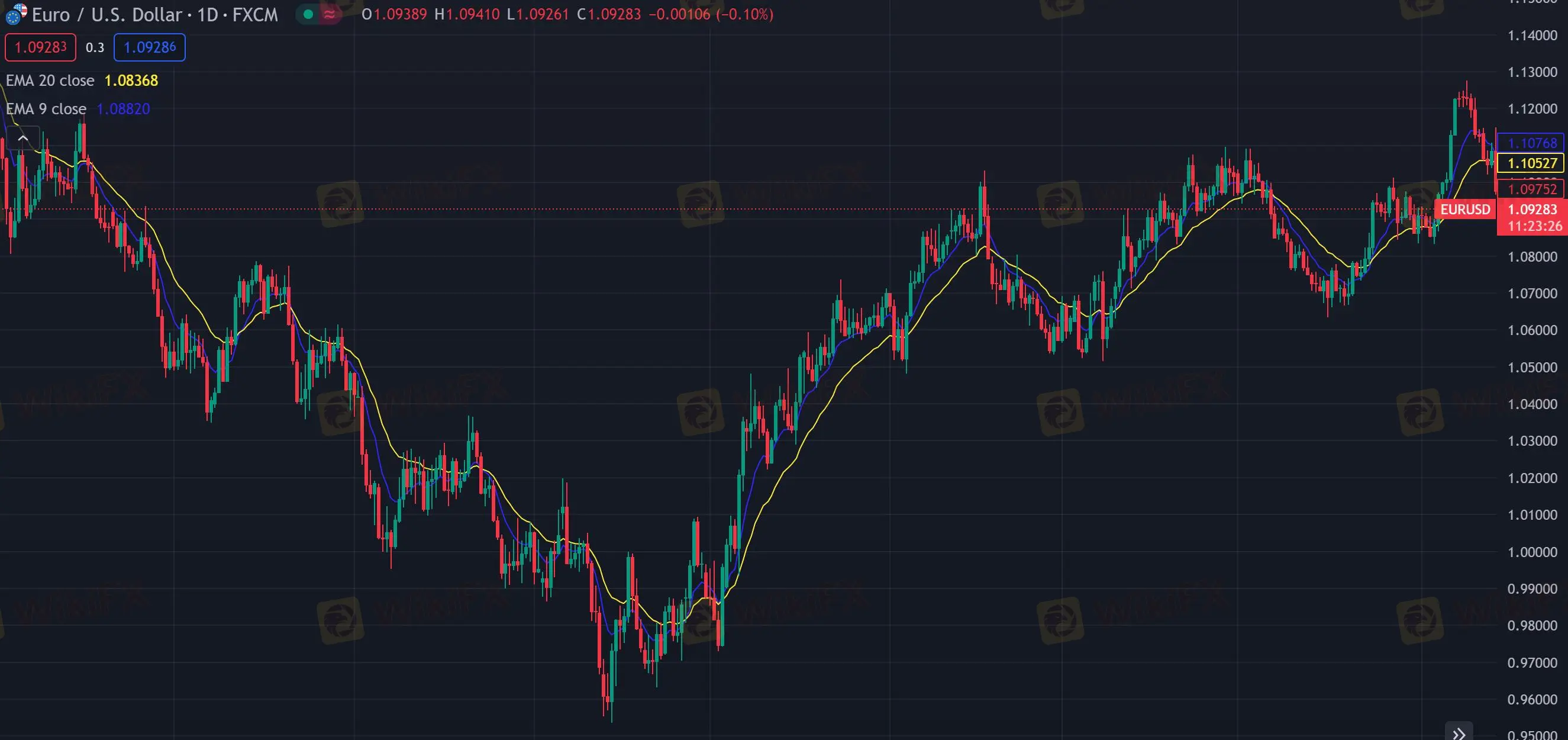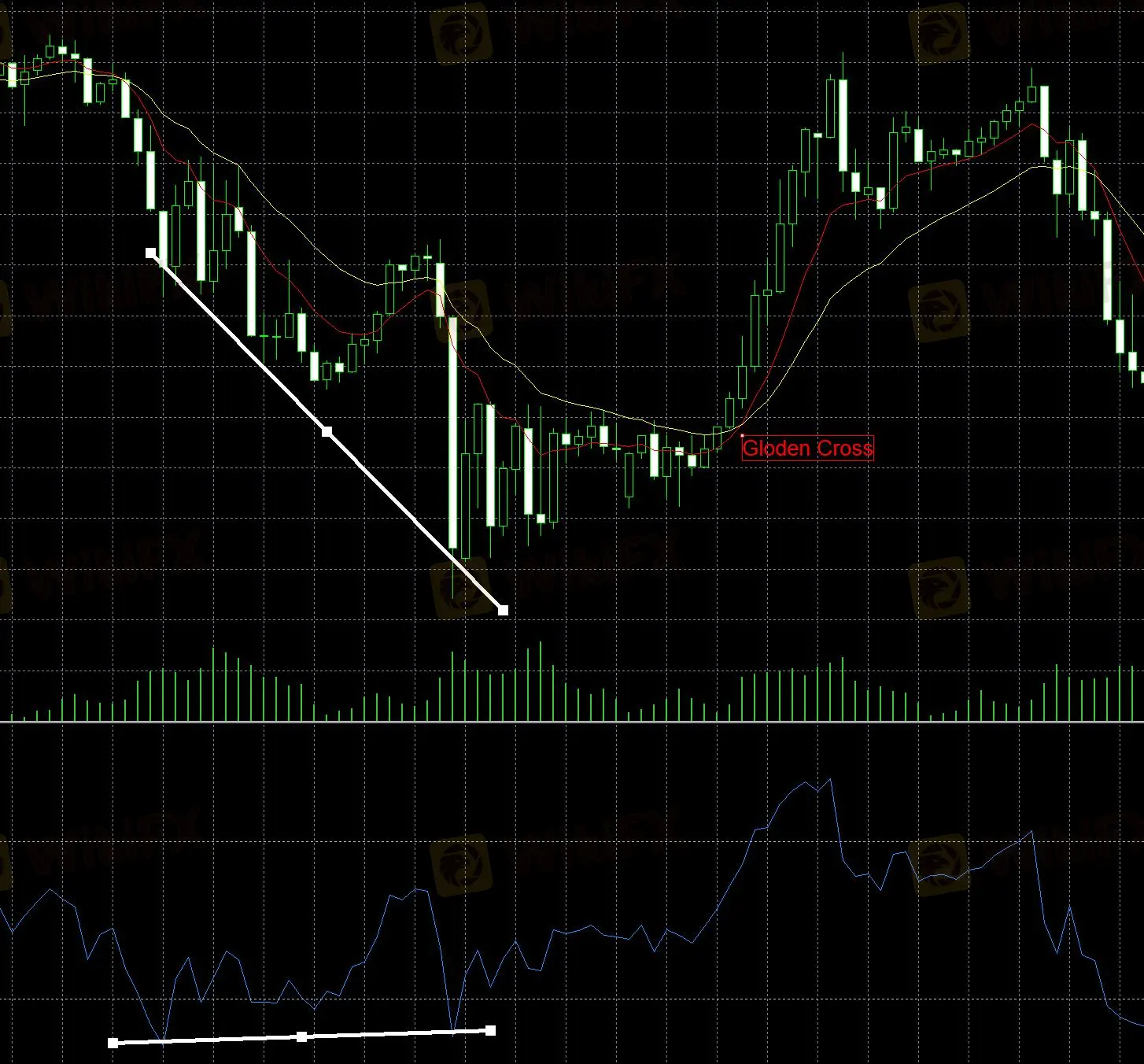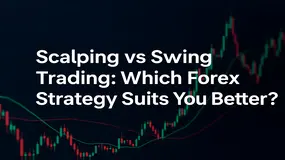简体中文
繁體中文
English
Pусский
日本語
ภาษาไทย
Tiếng Việt
Bahasa Indonesia
Español
हिन्दी
Filippiiniläinen
Français
Deutsch
Português
Türkçe
한국어
العربية
How To Day Trade With Moving Averages
Abstract:Every successful day trader adheres to a set of strictly followed trading systems and commonly used technical indicators, and moving averages remain a popular choice due to its user-friendly nature and high practicality. By using moving averages, traders can smooth out time fluctuations and more easily identify the future price trend, thus, featuring a higher rate of successful day trading.
Technical Indicators Commonly Used in Day Trading — Moving Averages
Every successful day trader adheres to a set of strictly followed trading systems and commonly used technical indicators, and moving averages remain a popular choice due to its user-friendly nature and high practicality. By using moving averages, traders can smooth out time fluctuations and more easily identify the future price trend, thus, featuring a higher rate of successful day trading.

Definition and Classification of Moving Averages
The moving average, abbreviated as MA, uses statistical methods to average the prices of a certain period, and connects the averages of different periods to form a smooth curve, mainly used to observe the price trend of an asset. Moving average theory is one of the most commonly used technical indicators among traders today. It helps traders confirm existing trends and potential reversals, guiding investment decisions.
Based on different data processing methods, moving averages are divided into three types: Simple Moving Average (SMA), Exponential Moving Average (EMA), and Weighted Moving Average (WMA). EMA and WMA are often confused. The difference is that EMA reduces price weight exponentially, while WMA reduces it linearly. Traders usually prefer using the EMA as a reference.
| Name | Calculation | Characteristics |
| Simple Moving Average | It is the average price obtained by summing the closing prices within a fixed time range and then dividing the total by the number of periods. | The accuracy of the signal is higher, but it has stronger lag. |
| Exponential Moving Average | It is a type of weighted moving average where more recent prices have a higher weight. The final value is the weighted average price. | Sensitive to changes in the latest prices, it may sometimes provide false signals. |
| Weighted Moving Average | It gives more weight to recent data. Unlike the EMA, the WMA calculates the average using a weighted formula. | In WMA calculation, the latest price factors have higher weights, which better reflect the current market sentiment. |
Common Moving Averages: EMA and SMA
The most commonly used indicators are EMA and SMA. Many people like to debate which of these two indicators is superior, but we believe that good indicators differ in terms of their characteristics and suitability. The main difference between EMA and SMA lies in the speed of indicator changes. EMA reacts to price changes faster, and its curve direction changes more quickly. When prices change, EMA responds more rapidly, but this can lead to false signals and result in incorrect trading decisions. For example, during a price rebound, EMA may signal a price direction change before SMA (as shown in the chart below, the yellow EMA5 line changes direction before the SMA5 line). Traders relying on EMA might make incorrect decisions based on these signals. In contrast, SMA changes direction more slowly. When prices are fluctuating within a fixed range, SMA will keep you in the trade longer, meaning you wont make incorrect investment decisions due to minor price fluctuations.

How to Choose Between EMA and SMA
Price movements are chaotic and difficult to interpret. Traders can only obtain effective information by using the most common moving averages. In other words, moving averages are useful for guiding investment decisions only when the majority of traders act based on their signals. Therefore, it is best to use moving averages that are widely adopted by most investors. If you are a high-frequency day trader, you need moving averages that react more quickly and sensitively to price changes. Hence, day traders typically choose EMA as their reference. In contrast, SMA has a lagging effect and is usually more suitable for long-term swing traders.
How to Choose the Period for Moving Averages
Price movements are chaotic and difficult to interpret. Traders can only obtain effective information by using the most common moving averages. In other words, moving averages are useful for guiding investment decisions only when the majority of traders act based on their signals. Therefore, it is best to use moving averages that are widely adopted by most investors. If you are a high-frequency day trader, you need moving averages that react more quickly and sensitively to price changes. Hence, day traders typically choose EMA as their reference. In contrast, SMA has a lagging effect and is usually more suitable for long-term swing traders.
Different trading styles require different periods of moving averages, which are generally categorized into short-term, medium-term, and long-term. Since moving average periods are not fixed, different traders can choose the moving averages that best fit their characteristics. Common short-term moving averages include 5, 9, 10, 14, and 15 periods. Medium-term moving averages include 20, 21, 50, 60, and 75 periods. Long-term moving averages include 100, 120, 150, and 200 periods. The table below outlines the main characteristics and uses of different time periods.
| Period | Characteristics | Suitable |
| 5,9,10 | Short-Term Moving Averages are more sensitive and can reflect the latest price changes in the market, making them more volatile and suitable for determining short-term market trends. | Day Traders and Short-Term Traders |
| 20,21,60 | Medium-Term Moving Averages have a sensitivity that falls between short-term and long-term moving averages. They are typically used to identify short-term support or resistance levels. | Swing Traders Calculating by Day or Week |
| 100,120,200 | Long-Term Moving Averages respond more slowly to market prices and exhibit less volatility. They are usually employed to identify long-term market trends. | Long-Term Investors |
As a beginner trader, we recommend choosing the most popular and widely used time periods in the market. This is because price changes are influenced by investor sentiment, and the effectiveness of moving average indicators depends on their frequency of use. Therefore, selecting the most commonly used periods will yield the best results. For short-term trading, choose EMA5, EMA9, and EMA10. For medium-term trading, choose EMA20, EMA21, and EMA60. For long-term trading, choose EMA100, EMA120, and EMA200.
How to Use Moving Averages
Determine Trends
In most cases, moving averages are employed in the market to identify the current price trend. Different periods typically use EMA50 and EMA120 to confirm the medium and long-term price trends. The principle is that when the long-term moving average is rising, it confirms a bullish trend; conversely, when the long-term moving average is falling, it confirms a bearish trend. Traders often use multiple moving averages to guide their trading. First, they determine the medium- to long-term trend based on larger timeframes, and then use shorter-period EMAs, such as EMA5 and EMA9, to guide day trading. This approach can significantly increase a trader's success rate.
The chart below shows the JPY/USD exchange rate from 2023 to 2024. From the chart, we can see that the price has been falling along the EMA120 and EMA50 moving averages, indicating a downward trend. Therefore, in 2023, day trading strategies focused on shorting would have had a higher success rate.

As shown in the chart, the EUR/USD exchange rate experiences a brief upward trend when the EMA50 crosses above the EMA120. During this trend, the success rate of day trading long positions would be higher.

Identifying Support and Resistance Levels
Moving averages also matters when it comes to determining support and resistance levels. Typically, in an uptrend, the moving average provides a support level for the price, while in a downtrend, it provides a resistance level. Identifying long-term trends relies on moving averages of larger timeframes, but support and resistance levels can be effective in the short term. Long-term support and resistance levels become more significant over time. Traders can also use these levels for stop-loss and take-profit strategies. For long positions, traders might set stop-loss orders when the price breaks below a support level and take-profit orders when the price reaches a resistance level.
The chart below shows the GBP/USD exchange rate changes. It is evident that the exchange rate has clear support at the white arrow positions. Whenever the exchange rate drops to the white arrow (EMA50), a notable rebound occurs, indicating the support level. Traders can execute buy orders at these support levels.

The chart below shows the downward trend of the EUR/USD exchange rate. According to the chart, it is evident that there is significant resistance at the white arrow positions. Whenever the exchange rate rebounds to these white positions (the resistance level of the EMA50 daily line), it tends to continue falling. Traders can perform short selling at these resistance levels.

Locating Trading Opportunities
Moving averages of different periods can sometimes cross each other, and these crossovers can be categorized into “Golden Cross” and “Death Cross”. “Golden Cross” also known as a bullish crossover, occurs when a short-term moving average crosses above a long-term moving average, indicating that the market is likely to experience an upward trend. Why is a “Golden Cross” considered a bullish signal? The reason is that moving averages represent the average price over a fixed period. When the short-term moving average is below the long-term moving average, it means that short-term prices are below long-term prices, indicating weak short-term performance. When the short-term moving average crosses above the long-term moving average, it shows that short-term prices are now higher than long-term prices, suggesting stronger future price movements.

“Death Cross” also known as a bearish crossover, occurs when a short-term moving average crosses below a long-term moving average, suggesting that the market is likely to experience a downward trend. Unlike the “Golden Cross”, where short-term prices rise above long-term prices, a death cross indicates that short-term prices have fallen below long-term prices. On the chart, this appears as the short-term moving average crossing below the long-term moving average, which increases the likelihood of weaker future price movements.

So how can you use golden and death crosses for trading? Whether you are a day trader or a short-term trader, you should focus on short-term price fluctuations. Therefore, you should select 4-hour or even shorter timeframes. The chart below is an hourly GBP/USD exchange rate candlestick chart. We can see that at position 1, the EMA9 crosses above the EMA20, forming a “golden cross”. At this point, we can consider taking a long position. At position 2, the EMA9 crosses below the EMA20, forming a “death cross”. Here, we can consider taking a short position.

Combining Moving Averages with MACD and RSI
Due to the lagging nature of moving averages, they can produce false signals. Traders should not rely on a single moving average for trading. Combining moving averages with other technical indicators can significantly improve the success rate. Commonly, moving averages are combined with indicators such as MACD and RSI in the market.
| Indicator | Definition | Usage |
| MACD | MACD is a momentum indicator that follows trends. Traders can use it to analyze the relationship between two moving averages. It mainly consists of the DIF , DEA , and MACD histogram. | When the DIF crosses above the DEA from below, it is a bullish signal. When the DIF crosses below the DEA from above, it is a bearish signal. |
| RSI | RSI is a momentum indicator that traders can use to analyze the magnitude of recent price changes. | When the RSI is below 30, the market is in an oversold state. When the RSI is above 70, it is in an overbought state. |
When the market experiences a golden cross with moving averages, and at the same time, MACD and RSI show bullish divergence, it typically represents a highly accurate buying point.

The chart above shows the EUR/USD exchange rate. We can see that RSI shows a bullish divergence at the bottom, with the price falling to a new range while the RSI does not break below the previous low. At the same time, a golden cross occurs with the moving averages. This phase represents a good buying opportunity.
Conclusion
Overall,day trading is a highly challenging and attractive trading method. Traders can take advantage of short-term market fluctuations to achieve substantial profits while avoiding overnight risk. Moving averages, on the positive side, provide day traders with an effective reference indicator. Traders can use long-term moving averages to determine trends, identify support and resistance levels, and use “golden crosses” and “death crosses” for day trading. For most traders, especially inexperienced beginners, it is advisable to start with long-term investing. Once sufficient experience is accumulated, they can challenge the more complex field of day trading.
FAQ
How to understand the lag effect of moving averages?
Moving averages calculate the average price over a certain period based on the current time, rather than using the current price. Therefore, the displayed price has a certain lag effect. As the selected period length increases, the lag effect becomes stronger, and the difference from the latest price may be larger. Thus, day traders are better suited to using shorter-period moving averages.
Why traders need to pay attention to long-term trends?
No trader can be 100% correct; from a certain perspective, trading is about probability. To achieve long-term profitability, traders must make choices with a higher probability of success. Day traders need to pay attention to long-term trends and trade in the direction of the trend to improve their success rate and achieve long-term profits. They shouldn't be limited to short-term fluctuations alone.
Are there any limitations to the application of moving averages?
The moving average is applicable to all types of investment assets in the market, such as stocks, futures, forex, and cryptocurrencies.
Disclaimer:
The views in this article only represent the author's personal views, and do not constitute investment advice on this platform. This platform does not guarantee the accuracy, completeness and timeliness of the information in the article, and will not be liable for any loss caused by the use of or reliance on the information in the article.
Read more

Top Tips to Avoid Forex Margin Calls and Protect Your Capital
While technical indicators or chart patterns often capture the attention of forex traders, especially new ones, aspects such as margin requirements, equity, used margin, free margin, and margin levels are often overlooked. So, if you have received a margin call from your forex broker and are wondering how to deal with it, you probably do not know the concept of a forex margin call - what triggers it and how to avoid it. Being unaware of this concept can make you lose your hard-earned capital. In this article, we will provide you with all the information you need to know. Keep reading!

Top 5 Forex Trading Mistakes to Avoid
Posting impressive forex trading profits requires attention to detail and impeccable discipline. Jumping straight into trading without meaningful preparation can dent your hard-earned capital. Despite being a profitable investment avenue, some traders face mountains of losses owing to common forex trading mistakes they commit. In this article, we have discussed the forex mistakes to avoid. Read on and implement these lessons when trading.

Scalping vs Swing Trading: Which Forex Strategy Suits You Better?
Confused about which to choose between scalping and swing trading? The basic difference between the two is this - While scalping involves quick trades meant to earn small profits, usually within minutes, swing trading focuses on larger price movements over a few days or even weeks. Keeping this in mind, we have shared the definition of scalping and swing trading, their pros and cons, and other critical insights. Keep reading to learn about which is better - forex scalping vs swing trading.

What is NFP in Forex? An Insightful Guide for Traders
The Non-farm Payroll (NFP) report may be for the US. However, the report, which is issued every month, impacts the forex market globally. The monthly report estimates the number of jobs gained in the US in the previous month. The job numbers stated on this report exclude those of farms, private households, and non-profit organizations. Usually released on the first Friday of the month, the report also includes the US unemployment rate, average hourly earnings, and participation rate. In this article, we have answered the question - what is NFP in forex - and shared other pertinent details. Read on!
WikiFX Broker
Latest News
Voices of the Golden Insight Award Jury | Tim Waterer, Chief Market Analyst of KCM Trade
Stonefort Securities Review: A Fair Look at Safety, Rules, and What Traders Say
Trump asks for meat packer probe over beef prices
Prop Firm Scams: When ‘Getting Funded’ Costs You Everything
PINAKINE Broker Review: A Complete Look at Its Services and Risks
One-Click Access to Broker Official Group Chats & Exclusive VPS Benefits
Consumer sentiment nears lowest level ever as worries build over shutdown
Uniglobe Markets MT4 Review: A Complete Look at Features, Costs, and Important Safety Issues
Is PINAKINE Broker Safe or a Scam? A 2025 Complete Review
Easy Money Doesn't Exist! High-Return Promise Turned into an RM44,000 Scam
Currency Calculator




